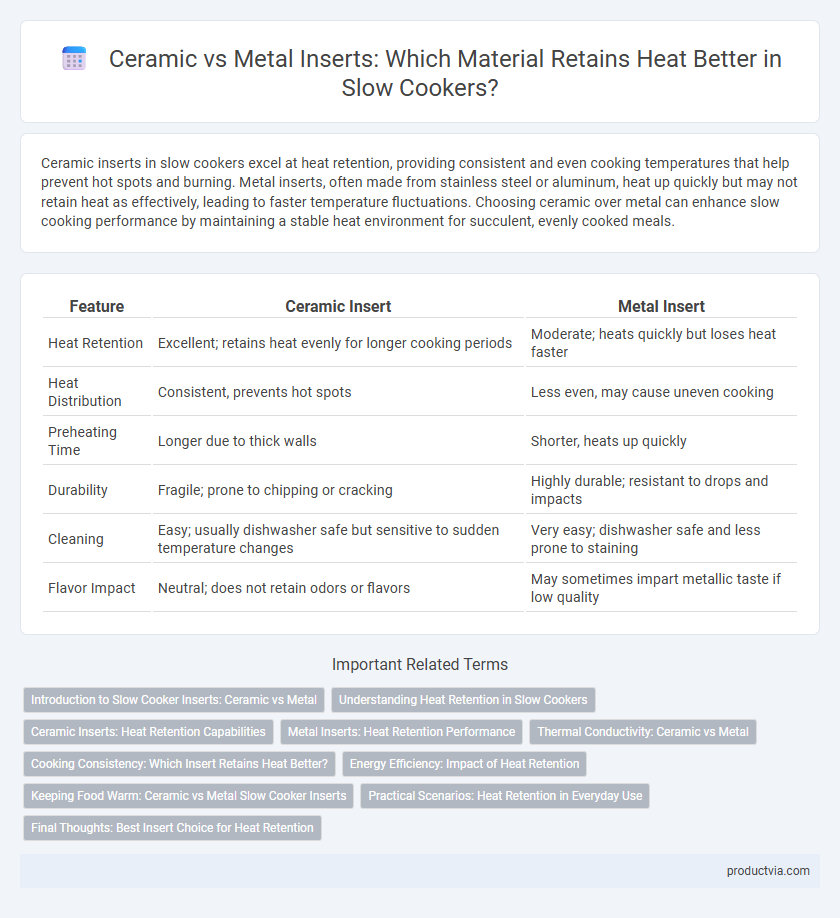Ceramic inserts in slow cookers excel at heat retention, providing consistent and even cooking temperatures that help prevent hot spots and burning. Metal inserts, often made from stainless steel or aluminum, heat up quickly but may not retain heat as effectively, leading to faster temperature fluctuations. Choosing ceramic over metal can enhance slow cooking performance by maintaining a stable heat environment for succulent, evenly cooked meals.
Table of Comparison
| Feature | Ceramic Insert | Metal Insert |
|---|---|---|
| Heat Retention | Excellent; retains heat evenly for longer cooking periods | Moderate; heats quickly but loses heat faster |
| Heat Distribution | Consistent, prevents hot spots | Less even, may cause uneven cooking |
| Preheating Time | Longer due to thick walls | Shorter, heats up quickly |
| Durability | Fragile; prone to chipping or cracking | Highly durable; resistant to drops and impacts |
| Cleaning | Easy; usually dishwasher safe but sensitive to sudden temperature changes | Very easy; dishwasher safe and less prone to staining |
| Flavor Impact | Neutral; does not retain odors or flavors | May sometimes impart metallic taste if low quality |
Introduction to Slow Cooker Inserts: Ceramic vs Metal
Slow cooker inserts significantly impact heat retention and cooking performance, with ceramic inserts providing superior heat distribution and gradual heat retention, ideal for even cooking of meals. Metal inserts, usually made of stainless steel, heat up quickly and cool down faster, offering durability and easier cleaning but less consistent heat retention compared to ceramic. Choosing between ceramic and metal slow cooker inserts depends on cooking style, with ceramic favored for slow, steady heat and metal preferred for quick heating needs.
Understanding Heat Retention in Slow Cookers
Ceramic inserts excel in heat retention due to their dense, porous structure, which allows even and consistent cooking temperatures over extended periods. Metal inserts, often made from stainless steel or aluminum, heat up quickly but lose heat faster once removed from the heat source, resulting in less stable cooking conditions. Understanding these properties helps in choosing a slow cooker insert that best suits recipes requiring steady, prolonged heat versus quicker cooking cycles.
Ceramic Inserts: Heat Retention Capabilities
Ceramic inserts excel in heat retention due to their dense, non-porous material that absorbs and evenly distributes heat, maintaining consistent cooking temperatures. Unlike metal inserts, ceramic retains heat longer after the slow cooker is turned off, allowing food to stay warm without continuous energy use. This superior thermal retention enhances flavor development and ensures thorough, even cooking ideal for slow-cooked meals.
Metal Inserts: Heat Retention Performance
Metal inserts in slow cookers excel in heat retention due to their high thermal conductivity, allowing for faster and more even heat distribution during cooking. Compared to ceramic inserts, metal retains heat more efficiently, enabling consistent temperature maintenance and reducing cooking time. This superior heat retention performance contributes to energy efficiency and improved cooking results in slow cooker operations.
Thermal Conductivity: Ceramic vs Metal
Ceramic inserts in slow cookers have lower thermal conductivity than metal inserts, allowing them to retain heat longer and provide more even cooking temperatures. Metal inserts, typically stainless steel or aluminum, heat up quicker due to higher thermal conductivity but cool down faster, leading to potential temperature fluctuations. Choosing a ceramic insert enhances consistent heat distribution and energy efficiency, while metal inserts offer rapid heating but may require closer temperature monitoring.
Cooking Consistency: Which Insert Retains Heat Better?
Ceramic inserts excel at heat retention due to their dense composition, allowing for steady and consistent cooking temperatures throughout the slow cooking process. Metal inserts, typically made from stainless steel or aluminum, heat up quickly but lose heat faster, resulting in more temperature fluctuations. For slow cooking recipes that demand gentle, even heat, ceramic inserts provide superior cooking consistency and improved flavor development.
Energy Efficiency: Impact of Heat Retention
Ceramic inserts in slow cookers provide superior heat retention compared to metal inserts, significantly enhancing energy efficiency by maintaining consistent cooking temperatures with less power consumption. The insulating properties of ceramic allow heat to be evenly distributed and held longer, reducing the need for frequent reheating. Metal inserts heat up faster but lose heat rapidly, leading to increased energy use and less efficient cooking cycles.
Keeping Food Warm: Ceramic vs Metal Slow Cooker Inserts
Ceramic inserts excel at retaining heat due to their dense material, providing consistent warmth that keeps food at a safe serving temperature for extended periods. Metal inserts heat up quickly but also lose warmth faster, making them less effective for maintaining steady heat once cooking ends. For slow cookers focused on prolonged food warming, ceramic inserts offer superior heat retention and temperature stability compared to metal ones.
Practical Scenarios: Heat Retention in Everyday Use
Ceramic inserts excel in heat retention, maintaining consistent temperatures longer after the slow cooker is turned off, ideal for keeping meals warm during family gatherings or overnight cooking. Metal inserts heat up quickly but cool down faster, making them suitable for recipes requiring rapid temperature changes or when reheating leftovers. In everyday use, choosing ceramic benefits dishes needing steady, prolonged heat, while metal is preferred for flexibility and quicker cleanup.
Final Thoughts: Best Insert Choice for Heat Retention
Ceramic inserts provide superior heat retention due to their thick walls and excellent thermal mass, allowing slow cookers to maintain consistent cooking temperatures for longer periods. Metal inserts, typically made from stainless steel or aluminum, heat up quickly but lose heat faster once removed from the heat source, resulting in less steady temperature control. For optimal heat retention and even cooking results, ceramic inserts are the preferred choice in slow cookers.
Ceramic insert vs Metal insert for heat retention Infographic

 productvia.com
productvia.com